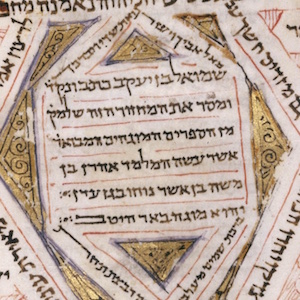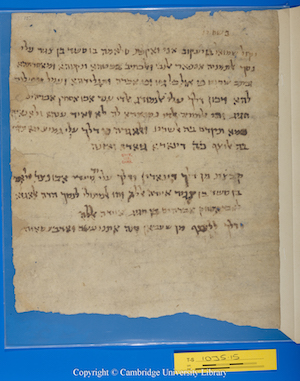Samuel ben Jacob: the Leningrad Codex B19a and T-S 10J5.15
The famous Codex Leningrad (St Petersburg, National Library of Russia, Firkovich MS. Hebrew I, B19a) is not a Cairo Genizah manuscript.1 Skilfully composed, furnished with gilded carpet pages, it passed through the hands of a succession of careful owners before attracting the notice of the great collector Abraham Firkovich (d. 1874). As far as we know, it was never discarded into the Genizah storeroom, instead remaining intact and treasured for a thousand years.
It could so easily have ended up in the Genizah, though, since it’s a product entirely of that world: from the early years of the Classical Genizah Period (late 10th–mid 13th century), from the cultural heart of Jewish life in Egypt, its scribe, its first and its subsequent owners have all left their mark in the Genizah Collection.
We are fortunate that it has survived intact, and this gives Codex Leningrad B19a an indisputable value as one of the most important witnesses of the masoretic text: the earliest complete dated codex of the Hebrew Bible, a masterpiece of the masoretic craft. The text of B19a forms the basis of the most widely used scholarly editions – Kittel’s Biblia Hebraica (BHK, in its third edition), the German Bible Society’s Biblia Hebraica Stuttgartensia (BHS), Aaron Dotan’s lovely Biblia Hebraica Leningradensia (BHL), and the newest, and least affordable, the yet-to-be-completed Biblia Hebraica Quinta. There are also online versions of the text, such as the Westminster Leningrad Codex, which are fast becoming essential tools.
From the pristine pages of BHS, BHK or BHL, and especially from the XML of the Westminster version, it is hard to get a flavour of the quality of the original manuscript. It is only when you see the layout of the individual leaves, the meticulous micrography, or the rich illustration in the carpet pages, that you can really appreciate the achievement of its creator.
The scribe of B19a is not well known, and you will scour the introductory pages of BHS in vain for mention of his name. There’s a thank-you for all involved – from printers through to spouses – bar the one person without whom the whole production could not have taken place, the remarkable sofer Samuel ben Jacob.
No one who has seen the original manuscript, photographs of the carpet pages or the excellent facsimile volume edited by David Noel Freedman et al (1998), can be in doubt of the identity of the scribe of B19a. His name appears in multiple places in the manuscript, in bare text, in poetry and in micrographic embellishment.

Detail of the decorative text on folio 479 of Codex Leningrad B19a, from Freedman, David Noel, Astrid B. Beck, and James A. Sanders. 1998. The Leningrad Codex: a facsimile edition, p. 969. Reproduced by permission of Koninklijke Brill NV.
Careful lettering proclaims שמואל בן יעקב כתב ונק׳ ומסר את המחזור הזה שלמק׳, ‘Samuel ben Jacob wrote, vocalised and furnished with masora this codex of the Bible’ (abbreviating the words ונקד and שלמקרא to fit the space left for the dedication in the middle of a carpet page, f. 479r). Similar messages appear on other carpet pages (e.g., f. 474r: ‘I, Samuel ben Jacob,…’). Samuel was responsible for all aspects of the work – consonants, vowels, accents and masora, as well as the decorative micrography (though perhaps not the decorations themselves).2 He was an expert scribe who would be expected to copy accurately and check his own work against suitable proof texts.3
Samuel’s clear expertise is also shown by the high fee he could command for his services. A decade after copying B19a, in 1021, Samuel was to be paid 25 dinars – a very large sum – for copying אלתמניה אספאר אלנבי ואלכתיב (‘eight books of the Prophets and the Writings’) including the vocalisation and masora (ונקטהא ומאסרתהא) in his usual fashion.4 The Judaeo-Arabic document attesting to this legal agreement is in the Genizah, T-S 10J5.15.5 Samuel agrees to copy the text of the Bible from an exemplar that he made and which is in the possession of Abraham ben Haggai (called by the Arabic version of his name, Abū Isḥaq Ibrahīm ibn Ḥujayj), who was a well-known administrator of the Jewish charitable institutions in early eleventh-century Fusṭāṭ.
Agreement with the scribe Samuel ben Jacob to copy the books of the Prophets and Writings, Cambridge University Library T-S 10J5.15
We don’t know how much Samuel was paid for copying B19a. It was likely to be less than he was promised in 1021, since it was much earlier in his career, but it was still a prestigious commission for a wealthy member of Egyptian Jewish society. There is a large amount of information in the long colophon of the work, which is on f. 1r of the codex: זה המחזור מקרא שלם נכתב ונגמר בנקודות ובמורסרות ומוגה יפה במדינת מצרים, ‘This codex of the complete Bible was written, furnished with vocalisation and masora, and carefully checked (hufʿal participle of נגהּ, ‘to check, revise’) in Medinat Miṣrayim’ and there then follows a succession of different systems of dating, which serve both to add to the gravity of the statements made in the colophon and to confuse us as to the actual date of its completion – none of the dates match one another exactly. It is worth noting that contrary to various other translations of the colophon (e.g. Lebedev in Freedman 1998: xxii; Würthwein 1957: 180), the work was executed in Fusṭāṭ, not Cairo.6 That Samuel should be working in Fusṭāṭ is entirely to be expected; though it was no longer the capital of Islamic Egypt following the Fatimid conquest of the country, it remained the administrative and, for the Jews, cultural centre of Egypt, a status it didn’t lose for a further two hundred years.
The dates that follow are given in the colophon in five different ways:
the month of Sivan in the year 4770 of the Creation (לבריאת עולם)
1444 of the Exile of the King Jehoiachin (לגלות המלך יהויכין)
1319 of the Seleucid Era (למלכות יונים שהיא למנין שטרות, though שטרות is erased in the text, perhaps because it was misspelled)
940 of the Destruction of the Second Temple (לחרבן בית שני)
399 of the Hijra (קרן זעירה, 'the Little Horn', a belitting epithet for Islam derived from Daniel 7:8).
These equate to 1010 CE (Creation), 1011 CE (Jehoiachin – the exile is dated to 433 BCE in Jewish reckoning), 1008 CE (Seleucid, known as ‘the Era of the Greeks’ or ‘the Era of Documents’), 1008–1009 CE (Destruction, though it could be broader, 1006–1010 CE, since Jewish reckoning of the date was slightly fluid), and 1008–1009 CE according to the Hijra. Würthwein’s (1957: 180) reasoning that the Hjira date is ‘the most trustworthy because the writer lived in an Islamic country’ is frankly nonsense, but 1008–1009 does seem to be encompassed by the majority of the dates presented. Hijra dating, though found in Genizah texts, is not a common system in use by Jews, particularly in the early Genizah Period.7 The Exile of King Jehoiachin was a system in use by the Karaites, and it is possible that Samuel would not have been as familiar with it as he would have been with the the other systems.8 The inclusion of Jehoiachin and the use altogether of these five different systems is a uniquely Karaite phenomenon in the Cairo Genizah, which can also be found in their marriage deeds (Olszowy-Schlanger 1998: 160). This brings me to the important discussion of the Karaite origins of our earliest, most complete copy of the Bible.
Was the scribe of B19a himself a Karaite? While it’s possible, and the colophon has a Karaite flavour, there is not a lot of evidence of Samuel’s origins and affiliation. As important, however, is the man who commissioned the Bible, Mevoraḵ ben Joseph, and he was indeed a Karaite. As befits such a significant figure for the history of the codex, he will take centre stage in part 2 of this extended Fragment of the Month.
Footnotes:
1 If it were, it would be digitised and freely available online by now, like the rest of the Genizah Collections worldwide, thanks to the generosity of the Friedberg Family of Toronto, http://www.jewishmanuscripts.org.
2 I’m understanding חקקתי in the micrography on f. 477r as referring to the creation of the micrographic embellishments themselves: אני שמואל חקקתי למבורך יחיה (‘I Samuel have inscribed this for Mevoraḵ – long may he live’). I may be over interpreting, however, and he's just using a grandiloquent term for his scribal work in general.
3 It is not unknown for a single scribe to prepare the whole text of a masoretic codex. Another example is St Petersburg, National Library of Russia, Firkovich MS. Hebrew II, B115, written and vocalised by Moses bar Hillel, and there are others.
4 Gil (1992: 234) presents evidence for a purchase price of 12 to 13 dinars for fine copies of the Bible, suggesting that Samuel’s work had a higher value.
5 E. Bareket (1995: 204–205) first published the complete text of this document, with a translation into Hebrew. Y. Ofer (1999: 197 n. 23) made the link with the scribe of B19a in his study of Samuel ben Jacob’s copy of Saʿadya’s Tafsīr, a manuscript that was featured in our Fragment of the Month for November 2009 by Ronny Vollandt (http://www.lib.cam.ac.uk/Taylor-Schechter/fotm/november-2009/).
6 Medinat Miṣrayim means Fusṭāṭ: the term occurs, for instance, in a divorce deed, T-S 8.154, in which a man from Alexandria (No Amon) divorces his wife from Fusṭāṭ (Medinat Miṣrayim) in Taṭay in 1052.
7 The legal document T-S 8J11.9, for instance, uses both Hijra and Seleucid dates – 546 and 1462 respectively – and is from 1151 CE.
8 In any case, in a society free from the tyranny of calendars on mobile phones, there were often egregious errors in recording the year. See, for instance, T-S 8J6.8, a court record from Fusṭāṭ, where the writer has recorded the date as 4994 of Creation (ד׳ אלפים ותשע מאות ותשעים וארבע), when he probably meant to write 4794 (ושבע מאות), i.e., 1034 CE, an error of 200 years!
Bibliography:
E. Bareket, שפריר מצרים (Tel Aviv 1995)
D. N. Freedman, A. B. Beck, and J. A. Sanders, The Leningrad Codex: a facsimile edition (Grand Rapids, Mich, 1998)
M. Gil, A history of Palestine (Cambridge 1992)
Y. Ofer, עיבוד מסרני של ערכים ממחברת מנחם בידי שמואל בן יעקב, Leshonenu 62 (1999), 189–255
J. Olszowy-Schlanger, Karaite marriage documents from the Cairo Geniza: legal tradition and community life in mediaeval Egypt and Palestine (Leiden, 1998)
E. Würthwein (translated by E. F. Rhodes), The text of the Old Testament: an introduction to the Biblia Hebraica (2nd ed.; Grand Rapids, Michigan, 1957)
Cite this article
(2016). Samuel ben Jacob: the Leningrad Codex B19a and T-S 10J5.15. [Genizah Research Unit, Fragment of the Month, January 2016]. https://doi.org/10.17863/CAM.7894
If you enjoyed this Fragment of the Month, you can find others here.
Contact us: genizah@lib.cam.ac.uk
The zoomable images are produced using Cloud Zoom, a jQueryimage zoom plugin:
Cloud Zoom, Copyright (c) 2010, R Cecco, www.professorcloud.com
Licensed under the MIT License

